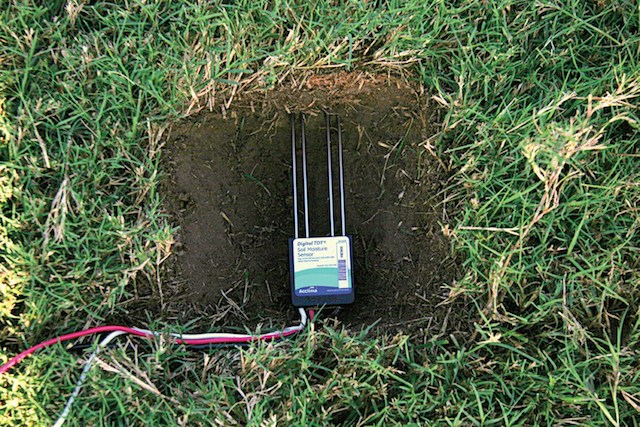By Mark E. Attard, CID, CLIA
What causes us as turf managers to “pull the trigger” on when to water the turf? With all the new technology available which one works the best? Our job as turf managers is to provide an adequate amount of moisture to the turf as to insure a healthy, green and safe playing surface. But proper irrigation scheduling is a tricky skill that many turf professionals have not mastered. By far the largest contributing factor to poor turf quality is improper scheduling. You might be surprised that the most common irrigation-scheduling problem is not too little water, or even too much water, it is watering too frequently!
So let’s take a look at the various “triggers”:
Smart controllers
Smart controllers provide specific irrigation scheduling for every zone based on the unique characteristics of each. The controllers use ET (evapotranspiration) to make adjustments to the irrigation schedule based on hourly weather data. They measure solar radiation, relative humidity, wind, temperature and effective rainfall. Run times and frequency of irrigation are automatically adjusted. There are various ways to retrieve this ET data according to which controller you select. Some controllers communicate with an on- site weather station that provides site-specific weather information.
Other controllers use weather data from a network of weather stations that is transmitted to weather satellites and other weather- tracking sources. The information is analyzed and converted to location specific ET data (accurate to one square kilometer) of the site and then transmitted to the controller. There usually is a monthly fee associated with this service.
There also are “add on” weather sensors that wire into a controller to make them “smart.” These weather sensors use a microprocessor to record and process weather data for use in establishing the watering schedule. Historical weather averages by zip code, rainfall amount, temperature and a solar sensor that monitors the sites sunlight exposure all factor into automatically adjusting the duration and frequency of the irrigation.
The ET or weather data received will only be useful if the controller has been programmed with the exact irrigation and site variables. Smart controllers and add on weather sensors both allow for programming the variables. These variables are: sprinkler type, efficiency rate, precipitation rate, soil type, plant type, root depth, microclimate, and slope factor. These variables are programmed into each zone so the irrigation schedule will be calculated for the optimum performance. Failure to have these variables correct will result in water waste, over or under watering and inefficient application of the water.
Soil moisture sensors
These sensors are by far the simplest, easiest to install and operate. There are two components to the system, the sensor probe and the receiver. The receiver wires into the controller and the probe is installed into the soil. Some models are wireless and can be installed up to 500 feet from the controller and others are wired directly to the irrigation system control wires. Depending on the controller make and model, multiple sensors may be operated off of one controller to match site variables.
So how do they work? The sensor continuously measures the moisture levels in the soil and then determines when to allow the controller to water. Most sensors automatically detect the soil type and make all the adjustments accordingly. The sensor will calculate field capacity for your soil type and set it at 100%. When the moisture level in the soil exceeds field capacity, the controller prevents the system from watering. Watering is delayed until the soil moisture level falls below 50%. The end user can adjust this level. It is important to know that the sensor only adjusts the frequency of the watering and not the duration. The user sets the station run times and watering days. Depending on the manufacturer, the receiver will also display the soil temperature, air temperature and detect freezing temperatures. For optimum water savings it is recommended that a rain sensor also be installed.
Site inspection
Rather than depend on smart controllers, weather sensors and soil moisture sensors perhaps we should consider the “old fashion” way. Get out into the field and see for yourself! A walk around the grounds can assist you in scheduling your irrigation system based on several factors:
- Are there any wet or dry spots?
- Is the system operating and controller on?
- How does it sound when I walk across the turf?
- What does the color of the turf look like?
- Do I just know it needs water based on instinct?
A soil probe is a useful tool to determine soil moisture level. Insert the probe into the soil in multiple locations around the site. Feel the dirt and make your determination if soil conditions are too wet, too dry or just right. Measuring or calculating the precipitation rate of your sprinklers and soil type by zone can assist you in setting an irrigation schedule that works for you and the turf.
I feel there is no best way to “pull the trigger.” A combination of irrigation water-saving equipment and regular site visits will result in an adequate amount of water being applied to the turf. This will give us the healthy, green and playable turf we strive for.
Mark Attard, CID, CLIA is an account manager with Kenney Outdoor Solutions, Grand Rapids, MI. Mark has more than 40 years of irrigation experience providing solutions and products to the turf industry.


